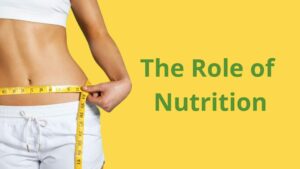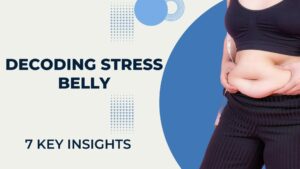Today, we explore the intricacies of effective fitness routines, with a specific focus on belly fat exercises. From understanding the health risks associated with excess abdominal fat to exploring diverse workout strategies and incorporating natural elements into your nutrition, this comprehensive guide aims to be your go-to resource in sculpting a trimmer waistline. Let’s unravel the science, embrace the workouts, and discover a holistic approach to well-being.
Table of Contents
Understanding the Health Risks
Excess belly fat poses significant health risks that extend beyond aesthetic concerns. Scientifically, it’s crucial to grasp the intricate relationship between belly fat and various health complications. High blood pressure, elevated cholesterol levels, type 2 diabetes, breathing difficulties, and an increased risk of heart disease are all intricately linked to the accumulation of fat around the abdominal area.
One of the primary concerns associated with belly fat is its classification into three distinct types: subcutaneous, intramuscular, and visceral. Subcutaneous fat, residing just beneath the skin, might seem innocuous, but its excessive presence can contribute to health issues. Intramuscular fat, found within muscle fibers, and visceral fat, situated deep within the belly and around organs, are particularly problematic. Even individuals maintaining a normal weight and body mass index (BMI) can experience health problems if burdened with excess visceral belly fat.
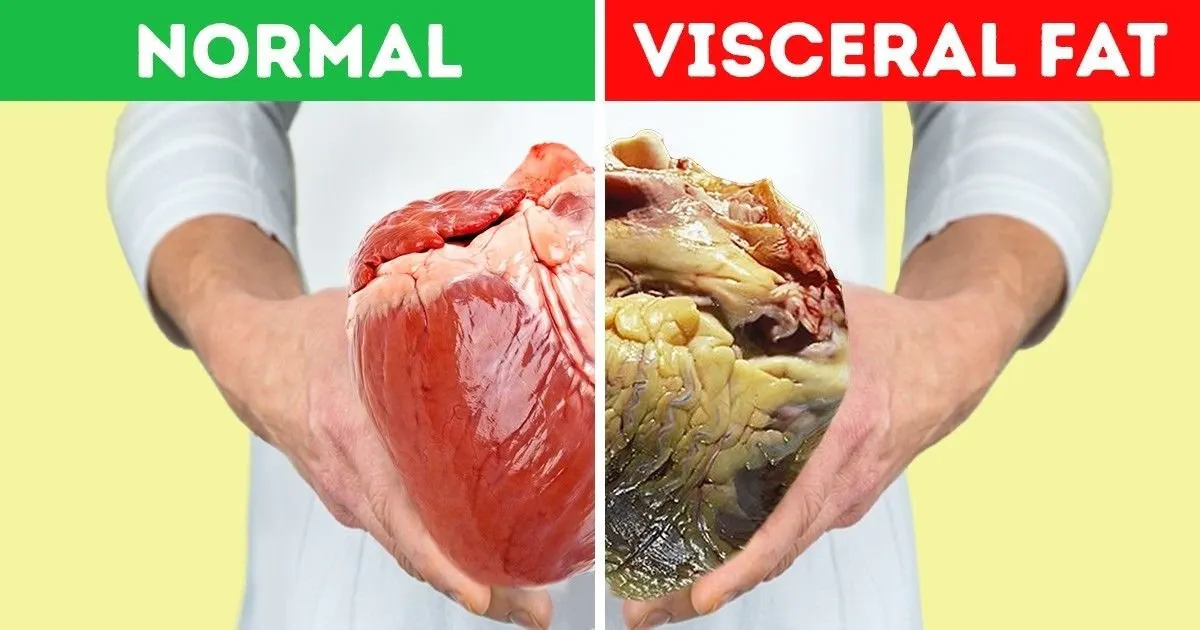
Research indicates that visceral fat is metabolically active, releasing hormones and substances that can negatively impact various bodily functions. This not only disrupts the balance of essential hormones but also increases inflammation in the body, contributing to insulin resistance, a precursor to type 2 diabetes.
Moreover, the release of free fatty acids from visceral fat into the bloodstream can lead to elevated cholesterol levels. This, coupled with the increased production of inflammatory molecules, sets the stage for cardiovascular problems. High blood pressure, a common consequence of excess belly fat, further compounds the risk, putting individuals on a potentially dangerous trajectory towards heart disease.
Additionally, the proximity of visceral fat to vital organs such as the liver can disrupt its normal functioning, contributing to fatty liver disease. This condition not only compromises liver health but also escalates the risk of metabolic disorders.
Understanding these health risks emphasizes the importance of actively managing and reducing belly fat. Adopting a healthy lifestyle that includes regular exercise, a balanced diet, and stress management can play a pivotal role in mitigating these risks. By acknowledging the multifaceted impact of excess belly fat on overall health, individuals can make informed decisions to safeguard their well-being.
Effective Belly Fat Exercises to Trim the Waistline
1. Aerobic or Cardio Exercise
Aerobic or cardio exercise stands out as a powerful weapon in the battle against excess belly fat. Scientific studies consistently highlight the efficacy of these exercises in reducing not only belly fat but also liver fat. The beauty of aerobic exercises lies in their versatility and accessibility, making them a feasible choice for individuals of all fitness levels.

Walking, especially at a brisk pace, offers a simple yet effective entry point into aerobic exercise. It’s a low-impact activity that can be seamlessly integrated into daily routines. Running, biking, rowing, swimming, cycling, and participating in group fitness classes are other dynamic options. The key is to choose an activity that brings enjoyment, ensuring sustained motivation in incorporating it into your regular routine.
The magic of aerobic exercise lies in its ability to elevate the heart rate and increase oxygen consumption. This not only burns calories during the activity but also triggers an afterburn effect, where the body continues to burn calories post-exercise. In the context of banishing belly fat, this extended calorie burn is particularly beneficial.
Studies have shown that consistent aerobic exercise contributes significantly to reducing visceral fat, the type that lurks deep within the belly and poses the most serious health risks. This visceral fat responds positively to the increased energy expenditure brought about by aerobic activities, leading to a healthier and leaner midsection.
The recommended starting point is a minimum of 30 minutes of aerobic exercise per day. This manageable commitment can be tailored to fit individual preferences, whether it’s a morning jog, an evening swim, or a lively cycling session. The emphasis should always be on sustainable, enjoyable activities to foster long-term adherence.
Aerobic or cardio exercise emerges as a cornerstone in the pursuit of a trim waistline. Its impact on reducing both belly and liver fat, coupled with its accessibility, makes it a valuable tool in promoting overall health. By incorporating aerobic exercise into your routine, you’re not just sculpting a leaner physique; you’re also taking proactive steps toward mitigating the health risks associated with excess belly fat.
2. HIIT or Interval Training
HIIT, or High-Intensity Interval Training, has emerged as a game-changer in the realm of fitness, especially when it comes to banishing stubborn belly fat. This innovative approach to exercise involves alternating short bursts of intense activity with periods of lower-intensity moves or rest. The result? An efficient and effective workout that can significantly contribute to controlling weight and enhancing overall physical condition.

Research consistently supports the effectiveness of HIIT exercises for belly fat reduction. These routines don’t demand extensive time commitments, yet they deliver remarkable results. The magic lies in the combination of intense bursts, lasting typically 30 seconds, with brief rest periods, keeping the heart rate elevated throughout the workout.
HIIT exercises incorporate a variety of movements, encompassing pushing, pulling, squatting, deadlifting, and loaded carries. This diversity ensures a comprehensive workout that engages multiple muscle groups simultaneously. The intensity and variety not only contribute to fat burning during the workout but also trigger an afterburn effect, where the body continues to burn calories post-exercise.
The simplicity and adaptability of HIIT routines make them suitable for individuals of all fitness levels and ages. Jumping jacks, burpees, pushups, jump squats, and high knees are just a few examples of HIIT exercises that can be easily integrated into a routine. The key is to select a handful of exercises, perform each for 30 seconds, followed by a 30-second rest, and repeat the cycle.
This approach not only saves time but also maximizes the benefits of the workout. The intense bursts of activity prompt the body to tap into stored fat for energy, promoting fat loss while preserving lean muscle mass. This dual effect is particularly advantageous when targeting stubborn belly fat, which tends to be resistant to traditional exercise methods.
Incorporating HIIT into your fitness routine doesn’t necessitate marathon sessions. In just 20-30 minutes, you can experience a full-body workout that keeps your metabolism revved up even after you’ve finished exercising. The short duration and efficiency of HIIT make it a practical choice for those with busy schedules, offering a potent solution for those striving to achieve a trimmer waistline.
HIIT or Interval Training is not just a trend; it’s a science-backed approach to turbocharging fat loss, especially in the abdominal region. By integrating these high-intensity workouts into your routine, you’re not only optimizing your time but also elevating your fitness journey to new heights, one intense interval at a time.
3. Weight and Resistance Training
When it comes to battling belly fat, don’t overlook the transformative power of weight and resistance training. This form of exercise, often associated with building muscle, plays a pivotal role in burning off excess fat and enhancing overall metabolic health. Let’s delve into the science behind it and understand why incorporating weights into your fitness routine can be a game-changer.

Muscles are the unsung heroes in the quest for a leaner physique. They not only provide your body with structural support but also act as calorie-burning powerhouses. The more muscle you have, the more calories your body burns at rest. This is where weight training steps in – by increasing muscle mass, you’re effectively creating a natural furnace that torches calories even when you’re not actively exercising.
Research has consistently shown that resistance training, a broader category encompassing weight training, can contribute to a reduction in body fat percentage. This is particularly relevant for belly fat, which tends to be more metabolically active and responsive to resistance exercises.
Bicep curls, lunges, squats, and tricep kickbacks are examples of weight training exercises that target various muscle groups while also engaging the core. The beauty of resistance training lies in its adaptability to different fitness levels. Whether you’re a beginner starting with lighter weights and higher repetitions or a seasoned enthusiast opting for heavier weights with fewer reps, the benefits remain substantial.
Furthermore, weight training doesn’t just rev up calorie burn during the workout; it has a lasting impact on your metabolism. Studies suggest that the post-exercise calorie burn, known as excess post-exercise oxygen consumption (EPOC), remains elevated after resistance training. This prolonged calorie burn can be a game-changer, especially in the context of melting away persistent belly fat.
It’s important to note that weight training isn’t solely about aesthetics. Beyond sculpting a toned physique, it contributes to overall health. The increased lean muscle mass promotes better glucose metabolism, reducing the risk of insulin resistance and type 2 diabetes. Additionally, resistance training has been associated with improved bone density, a critical consideration for long-term health.
Incorporating weight and resistance training into your fitness regimen doesn’t require hours at the gym. Even two to three sessions per week, focusing on different muscle groups, can yield significant results. Whether you’re lifting dumbbells, using resistance bands, or leveraging your body weight, the key is consistency and progressive overload.
Weight and resistance training offer more than just muscular definition; they’re potent tools in the fight against belly fat. By embracing these exercises, you’re not only sculpting a leaner you but also fortifying your body against a range of health risks. It’s time to pick up those weights and embark on a journey to a healthier, more resilient you.
4. Abdominal Exercises
When it comes to achieving a trim and healthy midsection, the significance of abdominal exercises cannot be overstated. These targeted exercises go beyond mere aesthetics, playing a pivotal role in enhancing core strength and overall well-being. Let’s explore why incorporating abdominal exercises into your fitness routine is more than just a pursuit of the perfect six-pack.

The abdominal region, often referred to as the core, is a central player in maintaining stability, balance, and posture. Beyond the desire for toned abs, cultivating a strong core contributes to improved functionality in daily activities and reduces the risk of injuries. Abdominal exercises specifically target this crucial area, encompassing a variety of movements to engage different muscle groups.
One of the primary benefits of abdominal exercises is their ability to tone and flatten the stomach. As these exercises engage the rectus abdominis, obliques, and transverse abdominis muscles, they contribute to sculpting a leaner and more defined midsection. However, the advantages extend beyond aesthetics.
Abdominal exercises promote better posture, a key factor in preventing back pain and maintaining spinal health. Strengthening the core muscles provides the necessary support for the spine, reducing the strain on the lower back. This is particularly significant in today’s sedentary lifestyle, where prolonged sitting often leads to weakened core muscles and subsequent discomfort.
Moreover, a strong core is linked to enhanced stability and balance. This has implications for everyday activities, from carrying groceries to navigating uneven surfaces. The benefits of improved balance extend to fall prevention, a crucial consideration, especially as we age.
5. Lower Ab Workouts
When it comes to achieving a sculpted and well-defined midsection, targeting the lower abs is often the key to success. Lower ab workouts play a crucial role in not only enhancing the aesthetic appeal of your core but also in fortifying your body’s foundation. Let’s explore why focusing on the lower abs is essential and delve into some effective workouts to tone and strengthen this specific area.
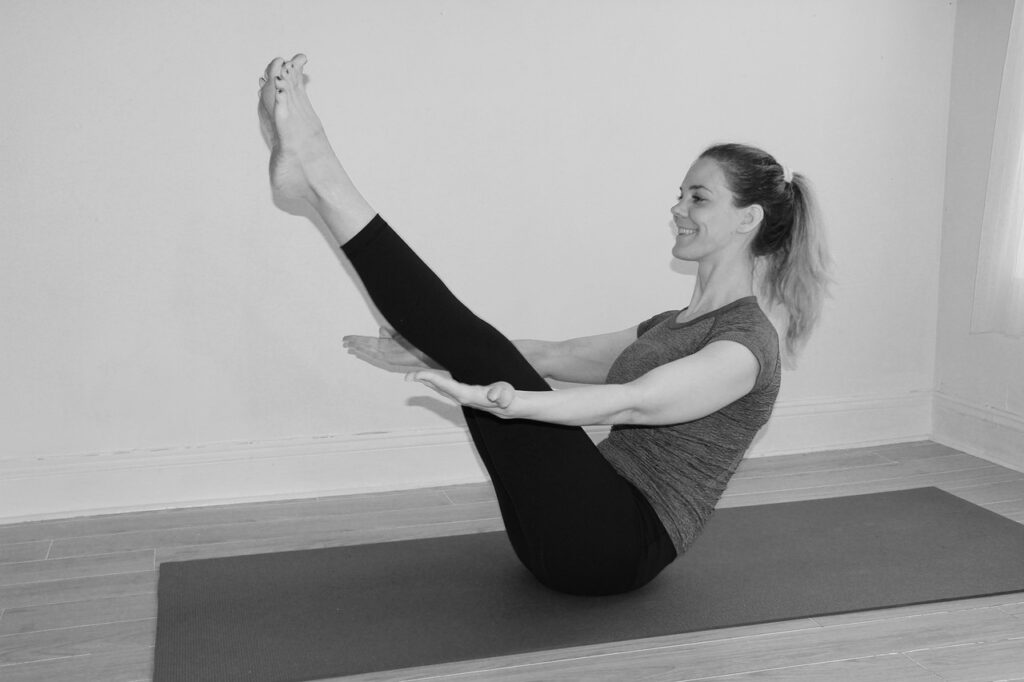
The lower abdominal region is notorious for being a challenging area to tone. However, understanding the anatomy and incorporating targeted exercises can yield significant results. The lower abs consist of muscles like the transverse abdominis and the lower fibers of the rectus abdominis. Strengthening these muscles not only contributes to a flatter stomach but also enhances overall core stability.
Here are some effective lower ab workouts that can be seamlessly integrated into your fitness routine:
- Mountain Climbers:
- Start in a plank position.
- Bring your right knee toward your chest, then return to the starting position.
- Repeat with your left knee.
- Increase the pace to engage the core and elevate the heart rate.
- Lying Leg Raises:
- Lie on your back with legs extended and hands by your sides.
- Lift your legs toward the ceiling, keeping them straight.
- Hold for a moment at the top and then slowly lower them without letting them touch the ground.
- Crunches:
- Lie on your back with knees bent and hands behind your head.
- Lift your shoulders off the ground, tightening your ab muscles.
- Curl your upper body toward your knees and then lower back down.
- Scissor Kicks:
- Lie on your back with legs extended.
- Lift your legs off the ground and perform a scissor-like motion, alternating between lifting one leg and lowering the other.
- Keep your lower back pressed into the floor.
- Knee Tucks (With Sliders or Exercise Ball):
- Assume a plank position with your feet on sliders or an exercise ball.
- Pull both knees toward your chest and gradually return to the starting position.
These exercises specifically target the lower abdominal muscles, helping to tone and strengthen this often overlooked area. It’s important to perform these movements with proper form to maximize their effectiveness and minimize the risk of injury.
Consistency is key when it comes to lower ab workouts. Aim to include these exercises in your routine at least two to three times per week. As you progress, consider increasing the intensity or trying variations to keep challenging your muscles.
Unlocking lower ab strength is not just about aesthetics; it’s about building a strong foundation for overall core stability. By incorporating targeted lower ab workouts into your fitness regimen, you’re not only sculpting a toned midsection but also fortifying your body for the demands of everyday life.
6. Adding a Natural Supplement
When it comes to achieving a healthier lifestyle, the integration of natural supplements into your nutrition can play a pivotal role. Among the myriad of health concerns, tackling belly fat is often a top priority for individuals looking to enhance their well-being. In this exploration of natural elements, we’ll uncover the properties of Golden Algae, Dika Nut, Drumstick Tree Leaf, Bigarade Orange, Ginger Rhizome, and Turmeric Rhizome, all known for their potential benefits in addressing belly fat. Discovering the natural power within these elements can be the key to a more holistic approach to nutrition and well-being.
Golden Algae: Golden Algae, scientifically recognized for its rich nutritional profile, offers a potent blend of essential vitamins and minerals. It is known for its potential to support metabolism, a crucial factor in managing belly fat. Additionally, the presence of omega-3 fatty acids in Golden Algae contributes to overall cardiovascular health, complementing efforts to address weight concerns.
Dika Nut: Derived from the Irvingia gabonensis tree, Dika Nut has gained attention for its potential impact on weight management. Studies suggest that Dika Nut may help regulate adiponectin, a hormone associated with fat metabolism. By influencing adiponectin levels, Dika Nut becomes a valuable addition to the natural arsenal against stubborn belly fat.
Drumstick Tree Leaf: The Drumstick Tree Leaf, or Moringa oleifera, is a nutritional powerhouse. Rich in antioxidants, vitamins, and minerals, it supports a healthy inflammatory response in the body. By promoting overall wellness and vitality, Drumstick Tree Leaf indirectly contributes to a balanced approach to weight management.
Bigarade Orange: Bigarade Orange, also known as bitter orange, contains synephrine, a compound believed to support metabolic function. This natural element has been studied for its potential to aid in weight management by enhancing calorie expenditure. Including Bigarade Orange in your nutritional supplement regimen may provide an extra boost to your efforts in addressing belly fat.
Ginger Rhizome: Ginger has long been celebrated for its digestive benefits. The Ginger Rhizome, with its bioactive compounds, aids in digestion and may contribute to a feeling of fullness. By supporting a healthy digestive system, Ginger becomes a valuable ally in maintaining a balanced approach to nutrition and weight management.
Turmeric Rhizome: Turmeric, known for its vibrant yellow color, contains curcumin, a compound recognized for its anti-inflammatory properties. In the context of belly fat nutrition, reducing inflammation is essential. Turmeric Rhizome, with its potential to modulate inflammation, adds a valuable dimension to your natural supplement choices.
Incorporating these natural elements into your nutrition provides a holistic approach to addressing belly fat concerns. It’s important to note that while these elements show promise, individual responses may vary. As with any nutritional change, it’s advisable to consult with a healthcare professional before making significant adjustments.
For those eager to explore a comprehensive solution that includes these natural elements, we recommend visiting this product page. It’s carefully formulated supplement harnesses the power of Golden Algae, Dika Nut, Drumstick Tree Leaf, Bigarade Orange, Ginger Rhizome, and Turmeric Rhizome. Additionally, this product reviews page offers insights from individuals who have incorporated this supplement into their wellness journey.
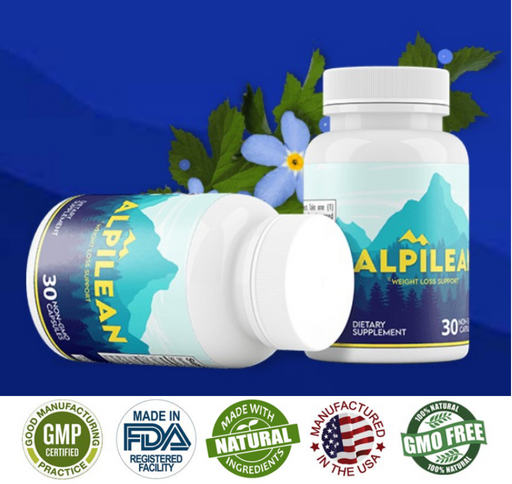
7. Staying Safe
While exercising is crucial, avoid overtraining, which can elevate cortisol levels linked to belly fat. Introduce new exercises gradually and seek professional advice if experiencing sharp or prolonged pain.
Conclusion
In the journey towards achieving a trimmer waistline and overall well-being, understanding the dynamics of belly fat and embracing a holistic approach becomes paramount. We’ve explored the importance of targeted exercises for visceral fat, delved into the realms of aerobic workouts, high-intensity interval training, weight and resistance training, and focused on effective lower ab workouts. Each facet contributes uniquely to the overarching goal of achieving a toned and healthy midsection.
Complementing these exercise strategies, we’ve ventured into the realm of nutrition, specifically addressing the significance of natural supplements. Golden Algae, Dika Nut, Drumstick Tree Leaf, Bigarade Orange, Ginger Rhizome, and Turmeric Rhizome have emerged as natural allies in the battle against belly fat. Their unique properties, from supporting metabolism to aiding digestion and managing inflammation, offer a multifaceted approach to holistic wellness.
As we conclude this exploration, it’s essential to highlight that individual responses to exercises and nutritional changes can vary. Consulting with healthcare professionals before embarking on significant lifestyle modifications is always advisable. The road to a healthier lifestyle is a personalized journey, and understanding one’s body is key to sustainable success.




